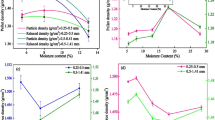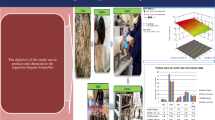Abstract
In Turkey 400,000 t/year of boron containing solid wastes are produced. The production of lightweight aggregates is a promising way to valorise these wastes. In the development of a suitable process the main disadvantage is borate migration towards the surface of the green pellets that causes excessive liquid phase formation during firing and subsequent sticking of the aggregates together or with the refractory lining of the kiln. In order to address this problem, fructose was added in the raw mix as a migration inhibitor, in 0.5 and 3.0 wt% respectively. The results have shown that 3.0 wt% of fructose lead to a sticky plastic mass whereas the pellets present no volume expansion during firing. The optimal results were obtained for 0.5 wt% of fructose addition, which inhibited the salt formation and a glassy impervious layer was formed after firing. For abrupt heating at 720 and 760 °C for 2 min, pellets were produced with porosity varying from 58 to 63 % and bulk density from 0.8 to 0.9 g/cm3. The individual compressive strength value of these samples was measured at 0.18 and 0.39 MPa, for 720 and 760 °C, respectively. The microstructure is comprised predominantly of a matrix with extended vitrified regions with both open and closed pores. Taking into account the relative low compressive strength values and the high water absorption, the possible applications of the boron containing lightweight aggregates could be insulation, geotechnical application, gardening and/or horticulture.





Similar content being viewed by others
References
Arioz, O., Arslan, G., Tuncan, A., Tuncan, M., Kaya, G., Karasu, B., Kilinc, K., Kivrak, S.: Lightweight expanded aggregate production from bottom ash. In: Heinrich, J.G., Aneziris, C. (eds.) 10th Conference and Exhibition of the European Ceramic Society, Berlin, Germany, pp. 2051–2053. Goeller Verlag (2007)
Fakhfakh, E., Hajjaji, W., Medhioub, M., Rocha, F., López-Galindo, A., Setti, M., Kooli, F., Zargouni, F., Jamoussi, F.: Effects of sand addition on production of lightweight aggregates from Tunisian smectite-rich clayey rocks. Appl. Clay Sci. 35(3–4), 228–237 (2007)
Ehlers, E.G.: The mechanism of lightweight aggregate formation. Ceram. Bull 37(2), 95–99 (1958)
Conley, J.E., Wilson, H., Klinefelter, T.A.: Production of lightweight concrete aggregates from clays, shales, slates and other materials. In: vol. 4401, p. 121. Report of Investigations, US Bureau of Mines (1948)
Riley, C.M.: Relation of chemical properties to the bloating of clays. J. Am. Ceram. Soc. 34(4), 121–128 (1951)
Aineto, M., Acosta, A., Rincon, J.M., Romero, M.: Production of lightweight aggegates from coal gasification fly ash and slag. In: World Coal Ash, Lexington, Kentucky, USA (2005)
Huang, S.-C., Chang, F.-C., Lo, S.-L., Lee, M.-Y., Wang, C.-F., Lin, J.-D.: Production of lightweight aggregates from mining residues, heavy metal sludge, and incinerator fly ash. J. Hazard. Mater. 144(1–2), 52–58 (2007)
Anagnostopoulos, I.M., Stivanakis, V.E.: Utilization of lignite power generation residues for the production of lightweight aggregates. J. Hazard. Mater. 163(1), 329–336 (2009)
Anagnostopoulos, I.M., Stivanakis, V.E., Angelopoulos, G.N., Papamantellos, D.C.: Valorization of lignite combustion residues and ferroalumina in the production of aggregates. J. Hazard. Mater. 174(1–3), 506–511 (2010)
Cheeseman, C.R., Virdi, G.S.: Properties and microstructure of lightweight aggregate produced from sintered sewage sludge ash. Resour. Conserv. Recycl. 45(1), 18–30 (2005)
Laursen, K., White, T.J., Cresswell, D.J.F., Wainwright, P.J., Barton, J.R.: Recycling of an industrial sludge and marine clay as light-weight aggregates. J. Environ. Manag 80(3), 208–213 (2006)
Tsai, C.-C., Wang, K.-S., Chiou, I.-J.: Effect of SiO2-Al2O3-flux ratio change on the bloating characteristics of lightweight aggregate material produced from recycled sewage sludge. J. Hazard. Mater. 134(1–3), 87–93 (2006)
Ducman, V., Mladenovic, A., Suput, J.S.: Lightweight aggregate based on waste glass and its alkali-silica reactivity. Cem. Concr. Res. 32(2), 223–226 (2002)
Kourti, I., Cheeseman, C.R.: Properties and microstructure of lightweight aggregate produced from lignite coal fly ash and recycled glass. Resour. Conserv. Recycl. 54(11), 769–775 (2010)
EtiMineWorks: http://www.etimaden.gov.tr. (2010). Accessed 7 June 2010
Mobbs, P.M.: The Mineral Industry of Turkey. US Geological Survey Minerals Yearbook (2004)
US Geological Survey: Mineral Commodity Summaries. BORON, pp. 32–33. (2010)
Smith, R.A.: Basic geology and chemistry of borate. Am. Ceram. Soc. Bull. 81(8), 8 (2002)
EuropeanCommission: Reference Document on Best Available Techniques for Management of Tailings and Waste-Rock in Mining Activities. chap. 3, pp. 236–238 (2004)
Austerberry, M., Stubbs, A.: Using borates in brick and roofing Tile. Ceram. Ind. 154(5), 31–37 (2004)
Christogerou, A., Kavas, T., Pontikes, Y., Rathossi, C., Angelopoulos, G.N.: Evolution of microstructure, mineralogy and properties during firing of clay-based ceramics with borates. Ceram. Int. 36(2), 567–575 (2010)
Christogerou, A., Kavas, T., Pontikes, Y., Koyas, S., Tabak, Y., Angelopoulos, G.N.: Use of boron wastes in the production of heavy clay ceramics. Ceram. Int. 35(1), 447–452 (2009)
Kavas, T.: Use of boron waste as a fluxing agent in production of red mud brick. Build. Environ. 41(12), 1779–1783 (2006)
Kurama, S., Kara, A., Kurama, H.: The effect of boron waste in phase and microstructural development of a terracotta body during firing. J. Eur. Ceram. Soc. 26(4–5), 755–760 (2006)
Kurama, S., Kara, A., Kurama, H.: Investigation of borax waste behaviour in tile production. J. Eur. Ceram. Soc. 27(2–3), 1715–1720 (2007)
Olgun, A., Erdogan, Y., Ayhan, Y., Zeybek, B.: Development of ceramic tiles from coal fly ash and tincal ore waste. Ceram. Int. 31(1), 153–158 (2005)
Kavas, T., Christogerou, A., Pontikes, Y., Angelopoulos, G.N.: Valorisation of different types of boron-containing wastes for the production of lightweight aggregates. J. Hazard. Mater. 185(2–3), 1381–1389 (2011)
Garret, D.E.: Borates, Handbook of Deposits, Processing, Properties and Use. p. 483. Academic Press (2005)
Stubbs, A.J., Evans, M.: Boron containing compositions for use in clay body e.g. brick manufacture. 2005. US 2005/0170945
Cirak, M.: Flocculation Behavior of Two Different Clay Samples from Kirka Tincal Deposit. Mining Engineering Department, Middle East Technical University MSc. (2010)
Pontikes, Y.: Utilisation of Red Mud in the heavy clay industry. PhD, University of Patras (2007)
Pontikes, Y., Esposito, L., Tucci, A., Angelopoulos, G.N.: Thermal behaviour of clays for traditional ceramics with soda-lime-silica waste glass admixture. J. Eur. Ceram. Soc. 27(2–3), 1657–1663 (2007)
Vagelatos, I.: Utilisation of Red Mud in the cement industry. Thesis, University of Patras (2008)
Anagnostopoulos, I.: Utilisation of lignite power genaration residues in the production of lightweight aggregates. Thesis, University of Patras (2009)
Council, Directive, 96/29/EURATOM: Laying down basic safety standards for the protection of the health workers and the general public against the dangers arising from ionizing radiation. In. (1996)
Giacovazzo, C., Menchetti, S., Scordari, F.: The crystal structure of tincalconite. Am. Mineral. 58, 523–530 (1973)
Christ, C.L., Garrels, R.M.: Relation among sodium borate hydrates at the Kramer deposit, Boron, California. Am. J. Sci. 257, 516–528 (1959)
Khoufi, S., Feki, F., Sayadi, S.: Detoxification of olive mill wastewater by electrocoagulation and sedimentation processes. J. Hazard. Mater. 142(1–2), 58–67 (2007). doi:10.1016/j.jhazmat.2006.07.053
Yashima, S., Kanda, Y., Sano, S.: Relationship between particle size and fracture energy or impact velocity required to fracture as estimated from single particle crushing. Powder Technol. 51, 277–282 (1987)
Beruto, D.T., Searcy, A.W., Kim, M.G.: Microstructure, kinetic, structure, thermodynamic analysis for calcite decomposition: free-surface and powder bed experiments. Thermochim. Acta 424(1–2), 99–109 (2004)
Thompson, L.G., Thomson, W.J.: A comparison of mineral reactions for two colorado oil shale samples. In: Symposium on Geochemistry and Chemistry of oil shale, Seattle, pp. 220–227 (1983)
Hunt, C.D., Benjamin, C.: BORON, Encyclopedia of Food Sciences and Nutrition. Academic Press, Oxford (2003)
Henricks, J.A.: Detergent composition containing 1,2 glycol borate ester. 1973. US 3755181
Pluim, H., Kraaijenbrink, J.G.: Method for separation organic substances. 1995. US005464514A
Geffen, N., Semiat, R., Eisen, M.S., Balazs, Y., Katz, I., Dosoretz, C.G.: Boron removal from water by complexation to polyol compounds. J. Membr. Sci. 286(1–2), 45–51 (2006)
Belcher, R., Tully, G.W., Svehla, G.: A comparative study of various complexing agents (polyols) used in the titration of boric acid. Anal. Chim. Acta 50(2), 261–267 (1970)
Navrotsky, A.: Thermochemistry of borosilicate melts and glasses-from pyrex to pegmatites. In: Grew, E.S., Anovitz, L.M. (eds.) Boron Mineralogy, Petrology and Geochemistry, vol. 33, chap. 4, pp. 165–178. Mineralogical Society of America (1996)
Crook, K.: Weathering and roundness of quartz sand grains. Sedimentology 11, 171–182 (1968)
Iqbal, Y., Lee, W.E.: Microstructural evolution in triaxial porcelain. J. Am. Ceram. Soc. 83(12), 3121–3127 (2000)
Acknowledgments
The authors acknowledge the support obtained within the framework of Erasmus and Turkish–Greek bilateral project 05TUR–046. Etibor Co. Kirka Borax plant, of Eti Maden Works, is also gratefully acknowledged for providing the boron samples.
Author information
Authors and Affiliations
Corresponding author
Rights and permissions
About this article
Cite this article
Christogerou, A., Kavas, T. & Angelopoulos, G.N. Synergy of Boron Containing Solid Wastes and Fructose for the Production of Lightweight Aggregates: Microstructure and Properties. Waste Biomass Valor 5, 733–741 (2014). https://doi.org/10.1007/s12649-013-9269-0
Received:
Accepted:
Published:
Issue Date:
DOI: https://doi.org/10.1007/s12649-013-9269-0




